
Armand Arnal Has Deservedly Earned Upper Echelon Chef Status with Two American Foodies
Today started with another visit to the spa. I figured out how to get the steam room really cranking and we both left feeling energized.
The Camargue was calling again. There are quite a few things to explore down there, but in short, it is divided into the west and the east side. Yesterday, we were in the west side and today, we wanted to check out the east side.
We knew we had a 12pm lunch reservation at La Chassagnette, and I had found out about a Rice Museum very close to the restaurant, so it was a perfect way to fill the morning. I had discovered the museum on a brochure that I received from the Tourist Office in Arles and was excited to learn about the cultivation and processing of this staple plantI went to a rice farm in Laos and wanted to compare and contrast how the rice was grown in the Camargue. As we pulled on site, Dan commented “it doesn’t look like any vehicles have been in here for a while.” It seemed rather deserted, but the two museum signs kept leading us on. Finally, we rounded the corner and there was the museum, with weeds crawling up the wall and clearly no visitors or curators for many a day. Our suspicions were verified as we peeked in the windows. The museum was occupied only by cobwebs and a few pieces of furniture resting on pallets that we assumed were to elevate them high enough to prevent damage when the rice paddies flooded. We laughed, because we had made sure to get here, before the two hour lunch hour, not on Monday, and before it closed for the season. In this case, we only missed it by a couple of years.

The Rice Museum that Has Not Been Functioning as Such in Many Moons
We continued south to the salt works observatory. Now this was an interesting sight. Les Salins de Giraud is very close to the mouth of the Grand Rhône, it’s about 1500 acres and approximately seven million pounds of salt are pulled out of these salt beds annually. This was large scale salt farming and was pretty much new to me. The salt ponds are manmade, carved out of the lagoons. The pans are designed to maximize surface area to increase the evaporation and, even though they have blue water in them, they give off a reddish tint, colored by the concentrations of minerals. We walked up to an observation platform and in the not so distant distance, we looked out at the mountain of salt. It was more like a mesa, with a flat top on it and large dump trucks roaming up the sides of the mesa and across the top. Compared to the size of the salt mountain, the dump trucks looked like Tonka toys. There was a road leading to the mountain, that went through the salt pans (probably an elevated dyke of some kind) and trucks just went back and forth and back and forth on the road. Going out to the pans, filling the trucks with salt, driving back and dumping it on the ever-changing mountain, and back out again. It has been a long time since I bought industrial produced salt and I don’t plan on starting to consume it anytime soon, but now I am really skeptical of it. Besides the fact that industrial salt has all the “impurities” (nutrients) removed from it, I am now thinking it has traces of rubber from truck tires and oil and car exhaust, from trucks driving over it. In the distance behind us, we saw a large factory, and this is where the salt is taken before being distributed around the world. The whole experience was a bit eerie, but educational nonetheless.

A Mountain of Salt- Literally!
We headed back to La Chassagnette, which is a farm to table restaurant on a rural piece of property, in between Arles and Le Sambuc, the small town where the salt factory is located. We had read about Armand Arnal, who trained under Alain Ducasse, and this alone was enough to have our interest piqued. As we walked inside, we were greeted warmly by the hostess and Armand, who was also in the lobby, shook our hands. He directed us to a larger table, thinking we’d be more comfortable there. We immediately felt comfortable in the elegantly rustic building, which has one wall painted with bright murals. The room has a lot of wood in it. The tables are sturdy and wooden and the walls are lined with hutch cabinets, also, made of quality wood. Revealed in them are the restaurant supplies – such as glasses, dishes, and some food staples like olive oil. I must add that there are plenty of seats outside as well and the garden intertwines itself over the tables, through arbors, lush with grape vines as well as some other less prolific vines, like passionflower and gourds. In summer, sitting outside in the gardens and enjoying an amazing meal to come would be the quintessential Provencal experience. But enjoying it inside was pretty amazing as well.
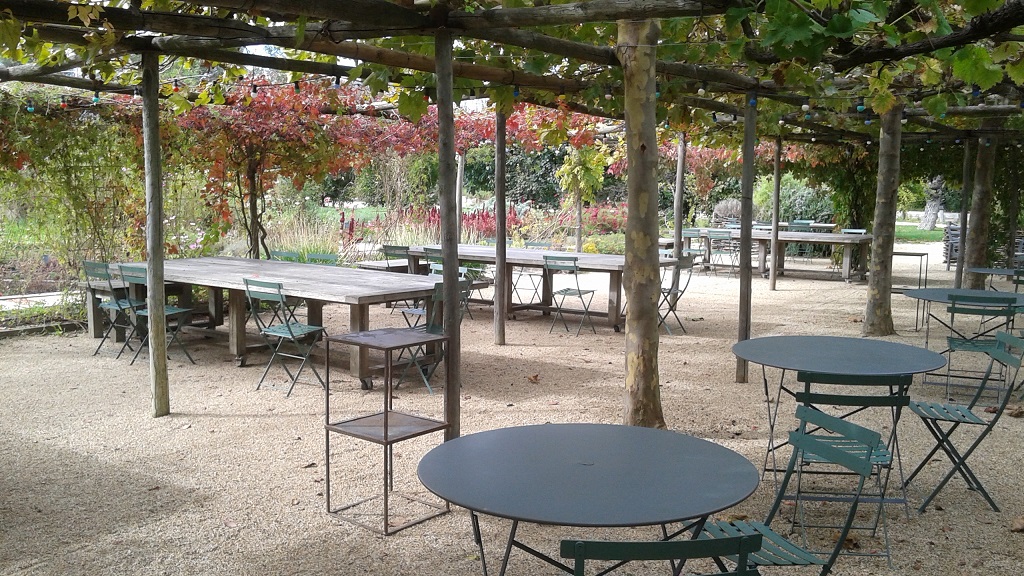
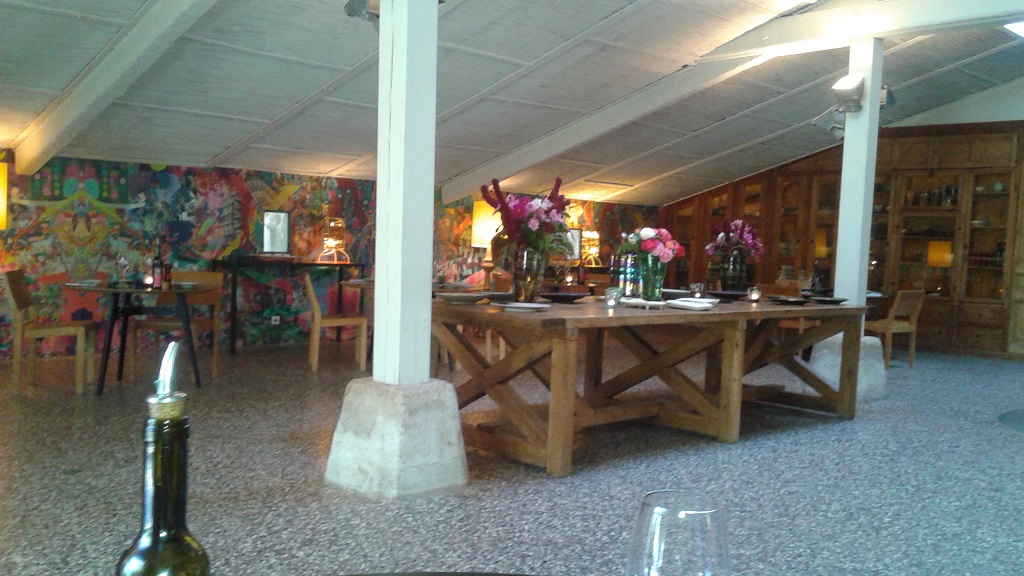
Both the Outside and Inside of Chassagnette Makes for a Superb Dining Experience
Armand spoke to us, asking us where we come from. When we told him Oregon, he immediately gave us a knowing look and commented what incredible mushrooms we have. He used to work with them, when he worked in NYC. I forgot to ask him what restaurant he worked for. I was also curious about what it was like for him to learn from the best in the industry. But the French are not ones to discuss personal matters and I held my tongue. He told us that the best two dishes on the menu would be the cod and the daurade, as the fisherman caught them last night and they were as fresh as it gets. We choose the tasting menu and the dishes are set, yet we did choose our main dishes, and totally trusted Armand’s recommendations.
Our amuse bouche was a large (plate sized) rice cracker with a lentil and sesame dip and jambon (ham). The rice and lentils were grown in the Camargue and the ham came from Avignon. Wonderful!

The Amuse Bouche
Dan asked for a bottle of Badoit, which is a sparkling water common in France (at all levels of restaurants) and the waitress let us know that they made their own, so we indulged.
Provence is not a land of butter, as the drier land does not support grazing animals in large quantity. Olive oil is the fat that the land gives birth to here and there was a bottle of it on the table. I sampled it and the flavor was rich and complex and in other circumstances, I could easily have gulped it down – but I didn’t want to look so uncultured!
The next dish was something like sliced radish root (or possibly another brassica), decorated with nasturtium flowers and leaves. The waitress poured a green sauce in the bowl and explained that it was made from herbs from the garden. The sauce had an earthy flavor, from a base of spinach, but also more complex and pungent herbs as an accent. Amazing!
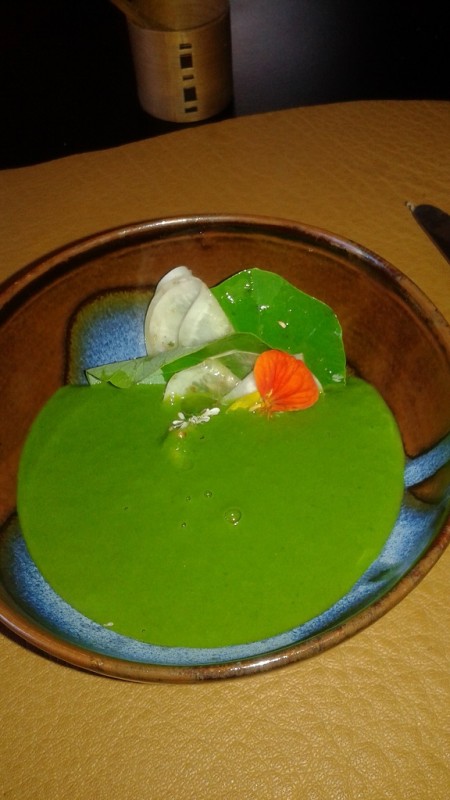
Earthy Spinach Sauce with a Nasturtium Kick
The next course came out on a couple larger plates and was designed for us to share (even though we always share plates whenever we eat out, because we like the variety). We were each given a small bowl with carrots, fennel, paper thin beets, arugula, turnips, bee balm flowers (which are a brilliant fuchsia color). There was a sauce on it, that tasted familiar, but neither of us could quite put our fingers on it. We asked the waiter and he told us it was made of haricot verts (green beans). This captivating dish made our taste buds dance in formerly undiscovered ways. Armand was clearly not missing a beat when his teacher Alain was showing him the ropes.
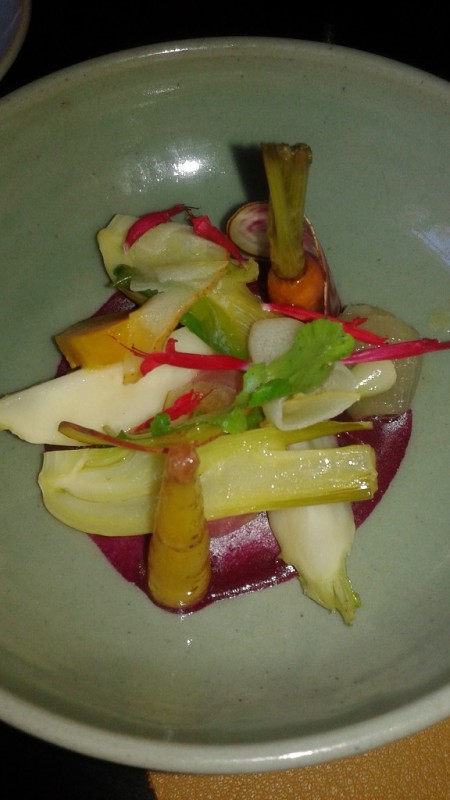
Color Is Used to Provide Contrast and Depth to a Root Vegetable Dish
The next dish to grace our table was octopus, with paper thin sliced green apple and savoy cabbage (which I love and is too underappreciated, IMHO), a mild chevre and a green sauce with extremely small bits of veggies. To accent the dish, there were borage flowers and calendula petals and parsley. I smiled, knowing that my summer salads often use these same garnishes. But hands down, Armand has got the plating thing over Sherri’s salads, any day of the week. This dish (and all of them so far, and all of them to come) were beauties to behold.

Octopus Accents a Fruit and Veggie Dish
As a side note, the waiters had delivered bread in a bag, literally a bag – a soft blue linen bag with what appears to be dry legumes sown into the bottom to give it structure. It was a wonderful touch. And inside the bag held a most delicious corn bread. Between the rice cracker at the beginning of the meal and cornbread, I realized Armand runs a gluten free restaurant. Whether this is intentional, or just a byproduct of what he chooses to feature, I was quite happy. Other than the glutinous food, I think French food is a very healthy cuisine.
Dan and I took note that the staff was informal, but consistent. They were not overtly taking care of us, like the Alain spectacle. Yet we had everything we needed and felt like they were well buttoned up. And they were a very young staff as well. Perhaps one man was in his late 20’s, but the other two appeared to be closer to 20. They had a most excellent work ethic, especially for their age. They were dressed in light brown corduroy pants and a simple white buttoned top – neat, matching, and informal. The formal can be fun, but it can also be stuffy. All else being equal, we both agreed our personal preference is informal.
Next came our main dishes, straight from the Mediterranean. Dan had braised sole, with turnips, carrots, arugula, and fennel. I had duraude laid on a bed of spaghetti squash, with succulent mussels and purslane (probably wild). They both tasted as spectacular as they looked and Dan and I each at half and then exchanged plates.
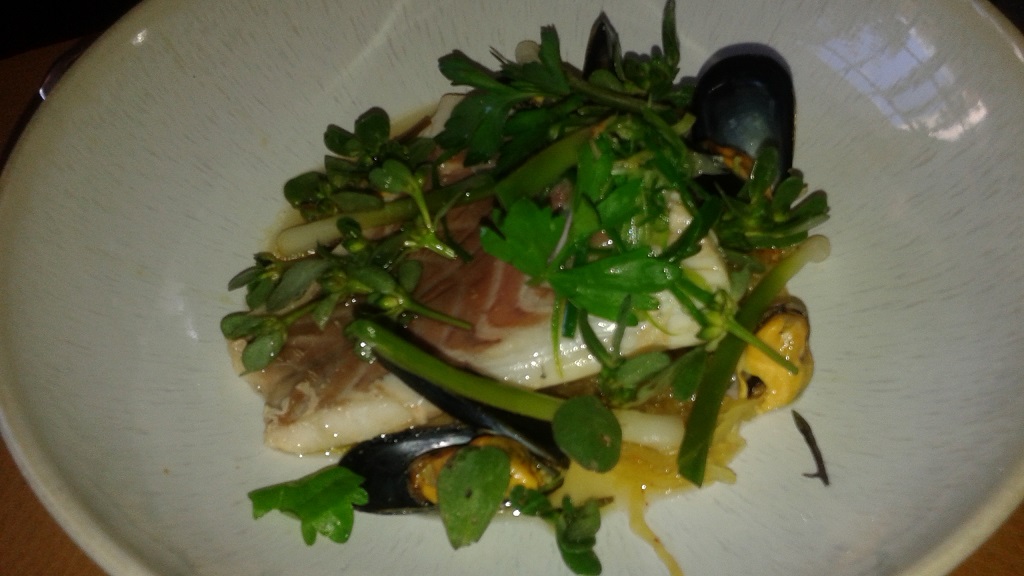
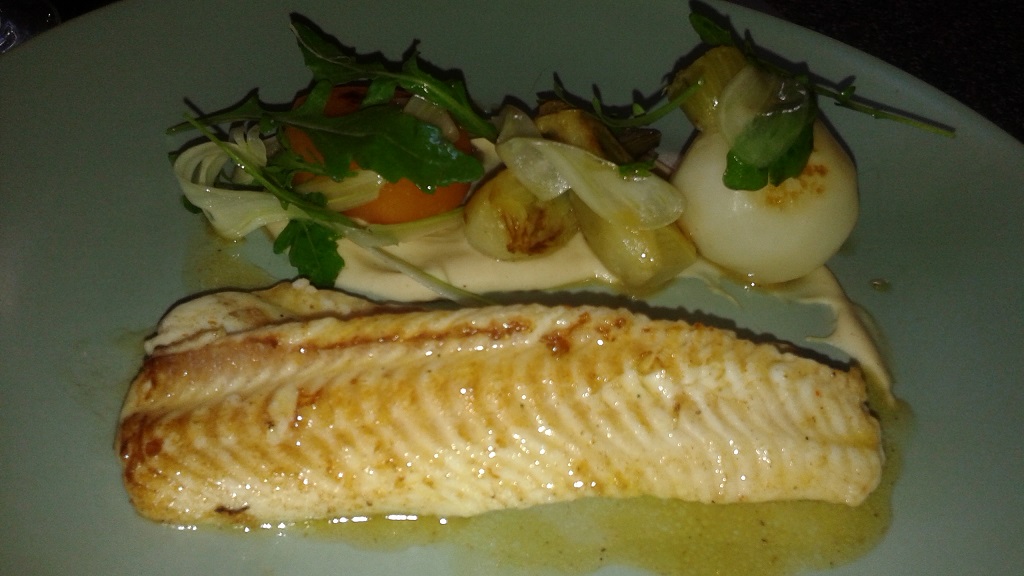
Armand Let Us Know the Fisherman Caught these Last Night
We noticed something about Armand’s cooking style that makes him unique. Firstly, his food is not exactly haute cuisine, as the portions are larger, although they are truly beautiful to look at. The upside of this tradeoff, is that he actually incorporates a larger portion of vegetables into each dish. In fact, most of the food we ate were vegetables, picked just yards from our table – the protein being an accent and not the focus, as in many other French restaurants. As far as Dan and I are concerned, we absolutely love the tradeoff. The other observation, is that Armand has mastered the preparation of the vegetables. And by this, I mean that he cooks/prepares the vegetables enough that they are not raw (raw food is for rabbits and basically indigestible to humans). But they are not well done either. Examples of well-done vegetables are sautéed, braised, roasted and pureed into soups – all of which are the main ways I prepare vegetables at home. I don’t believe I have ever tasted vegetables as thoughtfully prepared and as alive, as in this meal. Dan and I were kvelling over the entire meal and whole heartedly praising Armand. He has joined our very exclusive club of chef rock stars. As usual, we saw that we were going to shut the house down. We were the first to arrive and the other couple of tables of people have come and gone. Gifts come to those who linger.
As usual, I was not really hungry for dessert, but it came anyway. As I suspected, Armand served us dessert that was not sweet, as he would focus on fruit and how to showcase the existing flavors, instead of drowning it all with sugar.
We started with an apple grape gelée with an accent of fresh cream and filbert – I had but a taste and it was incredible. Next came a goat cheese panna cotta with figs. And then a tonka ice cream (not sweet) with a candied nasturtium. Now that was really being creative. The vanilla/chocolate/cherry like essence of tonka bean (we learned about it for the first time in cooking school a few days ago, it grows in the tropics) penetrated our being (and I am NOT exaggerating here). And the peppery bite of the nasturtium to cut through the grounding nature of the panna cotta. Yes, we can die now. Life is complete.

Perfectly Ripened Figs Mixed with the Exotic Tonka Bean Ice Cream
The French have a tradition of drinking tea or coffee after the meal has been completely consumed, not with dessert. I am not sure if there is a health reason behind this, or if it stems entirely from tradition. In most of the restaurants we skipped this part. Yet today, I went for some herbal tisane. The waiter asked me what type I wanted, and he named a few. I said vervain. I noticed vervain is common in France, and my guess is, it is warm enough in Provence to grow as a perennial. In Oregon, the winters get too cold and the vervain doesn’t survive and so it is essentially grown as an annual (this happens with a lot of plants in fact). The waiter went outside and we watched him pluck a handful of leaves off of a bush. He came back a few minutes later with a charming teapot steeping the vervain leaves. So sweet!
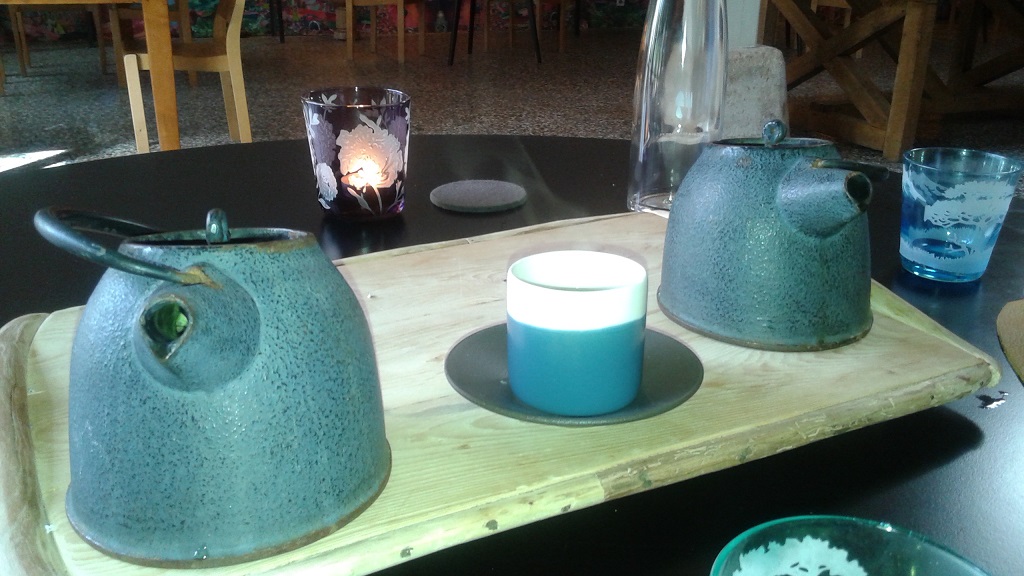
We Watched the Waiter Pluck Vervain Leaves to Order
At this point in our trip, I was growing rather accustomed to meeting the chefs and starting to think of it as an entitlement. I let the waiter know what an incredible meal and experience we have had here and to please let the chef know we are impressed and delighted on every level. This was all true, and I hoped it would result in Armand coming to say goodbye to us, as I had built up the courage to ask him about what it was like studying with Alain. The waiter told us the chef has gone home for the day, but he would make sure to pass on the message. Fair enough- he had probably been cooking since the sun rose and deserved to head out, as soon as the last plate of food passed muster.
We got up and walked to the centerpiece table. On it, are three luscious bouquets, all with flowers from the garden. The magenta amaranth jumps out at us. Even the flower arrangements were artistic – the colors that were placed together in each vase and then how they were arranged in the vase. I believe this is the case with all excellent Michelin starred meals, yet the experience at Chassagnette drove home the point, that eating here is truly patronizing the arts. Just like a ballerina or a painter, goes to school, studies their craft intensely and by the time the public gets to see their offerings, an immeasurable amount of time and energy and money has been invested in perfecting their craft – the same can be said for a top rated chef. The restaurant itself is a work of art (either the building or the décor or both) and the people who serve us take great care in delivering stellar service and perhaps most importantly, the food has been prepared in a most caring and artistic way, from the technique down to how each component is laid before our eyes on the plate.

Ze Details Très Élégants
While we were checking out, we asked if we could look at the gardens, and we were told that yes we could, and, indeed, we should. The gardens are very well tended, but in no way sterile. Close to the restaurant are arbors and on them are grapes, as well as gourds and a type of ivy (autumn red with navy berries – stunning), and passionfruit.
As you move further away, there were a handful of large veggie beds with a wide variety of plants in them. The usual with lettuces and chard, but also sunflowers and a magenta lambs quarter. A stone statue sits in the middle aisle, tying it all together. Rose bushes frame parts of the garden, many of which still had petals on them, even this late in the season.
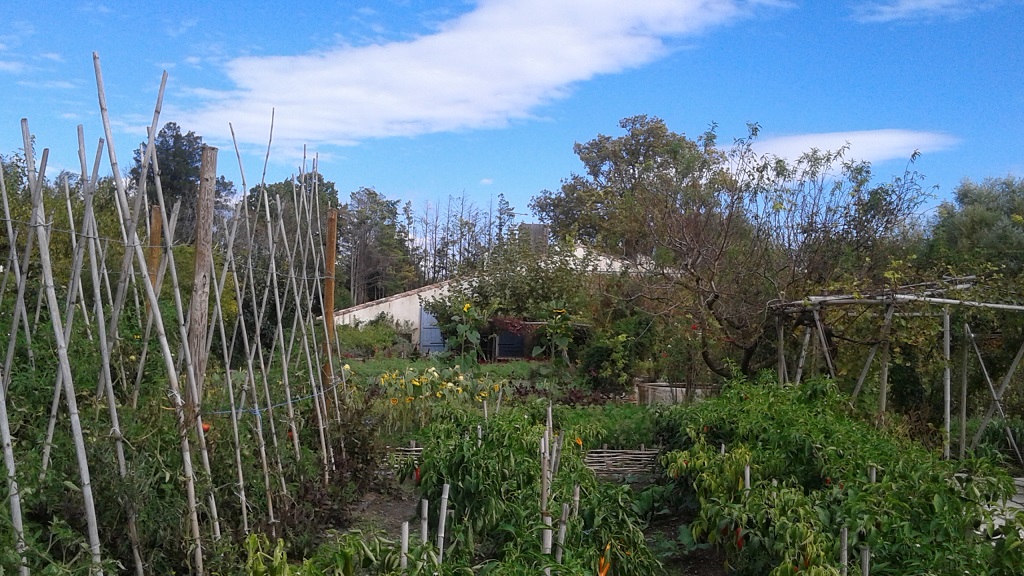
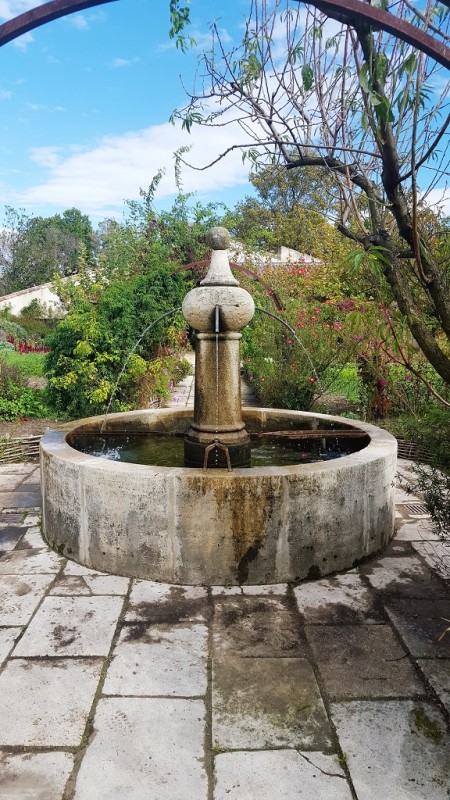
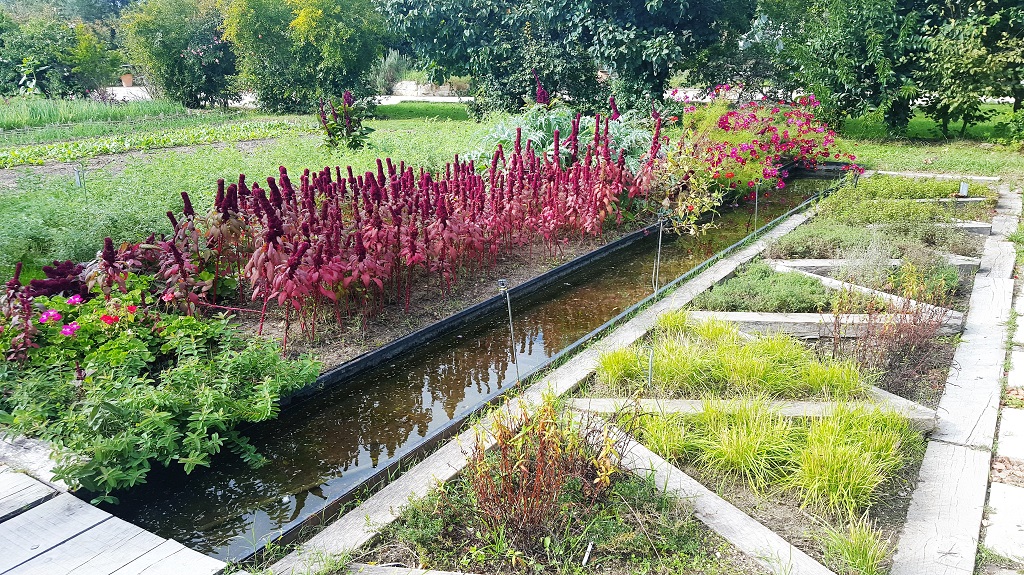

I Love to Visit Gardens When I Travel
Heading back toward the car, we walked through the orchards. Apples and pears were plentiful, but what really caught my eye were the olive trees interspersed among the pomegranate trees, which surely yielded the pomegranate seeds we were served for lunch.
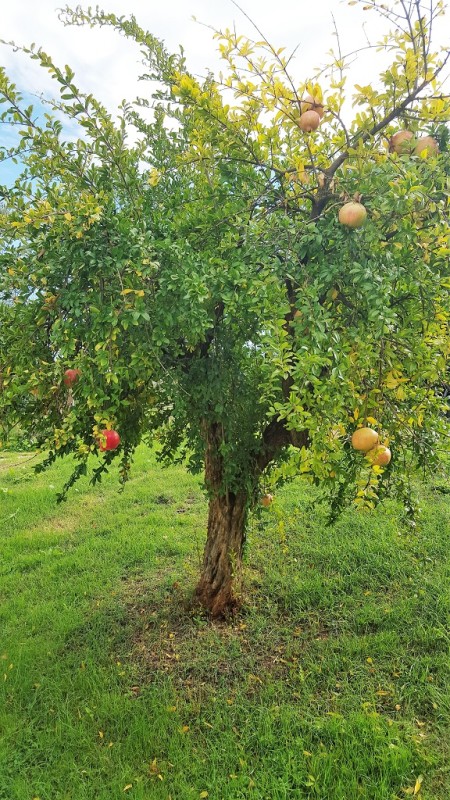
Pomegranates Grace the Gardens and Our Salads
Dan and I both were riding some sort of high (if a gastronomic high is such a thing). Armand Arnal is a young chef who is a master of what he does. Every single detail was well thought out, from the location of his restaurant, to what variety of vegetables he planted, to who sources the olive oil, salt and rice grown within 20 miles of his establishment, to the flower arrangements inside, and the attentiveness of his passionate staff, in his most beautiful rustic building. Armand is officially on our radar and I am eager to learn more about him. We want to patronize chefs that are as devoted to their art as they can possibly be. French chefs are amazing cooks, and some of them are amazing at creating an atmosphere that enlivens all the senses. And we were fortunate enough to be part of this impeccably executed show today.
We headed south toward the small town of Port St-Louis, which is where the Rhône flows down into the Mediterranean Sea. It’s not a particularly pretty town and it lacks the tourist vibe of St Marie de la Mar. It does have Tour (Tower) St Louis, which houses the tourist office. The first floor has an exhibit on the birds in the Camargue. They were real birds that have been stuffed and preserved. Even in this little room, they are broken up into sub-regions of the Camargue, which makes it so evident that there are so many micro ecosystems in the world and that the world is so vast, that I can only ever attempt to scratch it. Climbing to the 2nd floor, we went atop the roof and had a sweeping view of the Camargue. There is a lot of industry down there and the scenery was a mixture of a wide expanse of wetland, with a smattering of the ugly parts of the world, that yield people the products that we choose to employ in our daily lives.
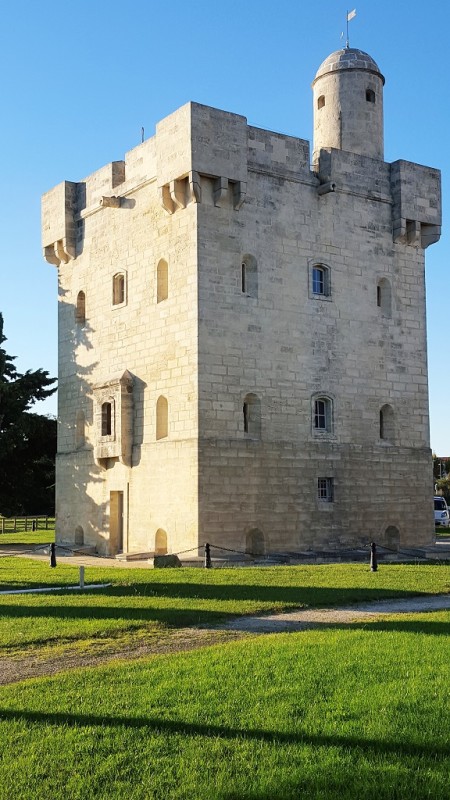
Tour (Tower) St-Louis
There is a road that leaves from Port St-Louis to the sea. We did a 90 minute power walk on it, but we didn’t make it to the sea, that would likely have been closer to a three hour walk (there and back). We were surrounded by wetlands and tall sedges growing in the swamps and if you listened closely, you could hear the birds. Further back from the road, we passed a ship yard with hundreds of yachts, and cranes that lift large shipping containers (did you know 100,000 of them go missing each year from the system and people keep them for themselves, like a premade shed), a power plant, and an oil refinery. There was some part of me that took solace knowing that even France has its ugly parts, and not everything is très élégant.
Having gotten so close to the sea, but not reaching it – I was determined that we needed to say hello to the Med, up close and personal. So we drove down the same road that we had walked and it ended at the beach. The water was cold and it was hard to imagine that weeks earlier, thousands of people were there swimming in it. That wasn’t enough to stop me from splashing it on my face. This was my first time touching the Mediterranean Sea, but certainly not my last.
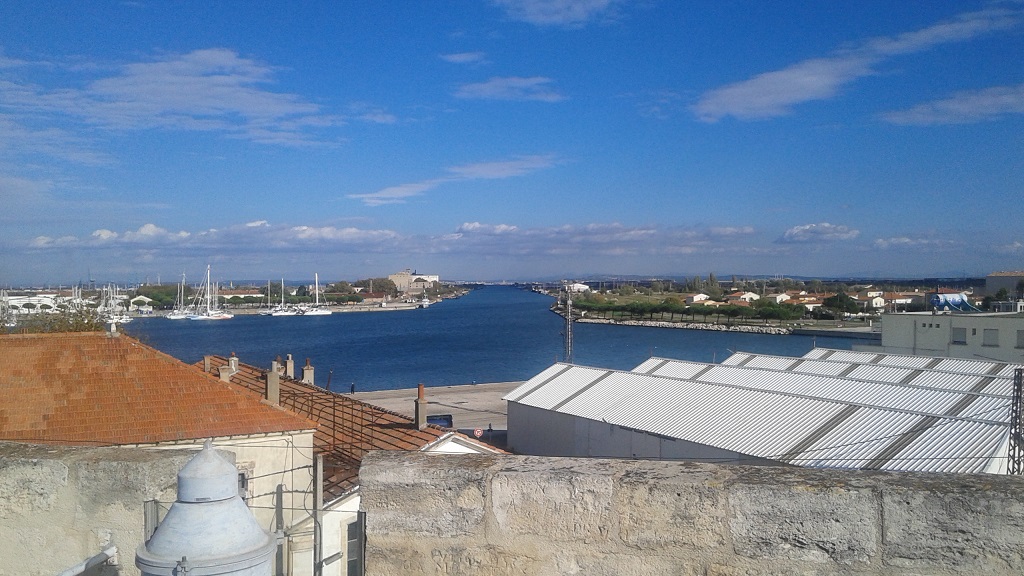
The Rhone Flows into the Mediterranean
